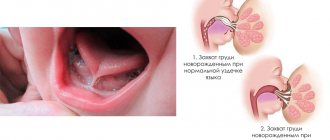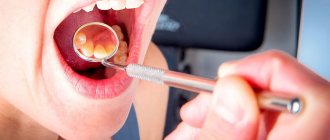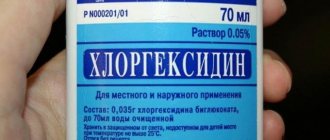The reasons for the appearance of this formation
A blood bubble on the tongue is nothing more than a hematoma.
The epithelial tissues located above the wound are stretched, which, combined with the effect on the nerve endings, results in severe pain. Vascular rupture is the main cause of a blood bubble on the tongue.
Provoking factors can be divided into two groups:
- Pathological.
- Traumatic.
As a rule, blood vessels rupture if the integrity of the mucous membranes is disrupted.
Factors may include:
- Thermal impact. A fluid-filled blister on the surface of the tongue may represent a common burn caused by drinking hot food or tea.
- Chemical damage. The circulatory network located in the oral cavity is very sensitive to the effects of external irritants. Carbonated drinks that contain flavorings and dyes, salty, spicy foods - all this can have a detrimental effect on sensitive mucous membranes. Why does a blood blister form on the side of the tongue?
- Mechanical injuries. Chips, grilled meats, fish bones, and candies are typical enemies of healthy mucous membranes in the mouth. Hard and sharp food components can puncture blood vessels, thereby causing hemorrhage. Often such phenomena are observed in children under 3 years of age who are trying to taste everything. In addition, there is a high risk of mechanical injury when visiting the dentist.
The formation of a blood bubble on the tongue is a normal protective reaction of the body to an external irritant.
Which doctor should I contact for help?
When a vessel on the tip of the tongue bleeds, you need to visit a doctor. Do not hesitate to visit a doctor if you have the following symptoms:
- Prolonged bleeding.
- The wounded area of the muscle organ was severely swollen.
- Painful sensations increase.
- A hematoma formed, pus, strong furrows and plaque appeared.
- There is a burning sensation when eating.
- Damage to the muscle due to penetrating damage to the organ.
These problems are aggravated by the entry of pathological microflora into the wound. The first thing you should do is see a dentist. In difficult cases, consultation with a therapist, ENT doctor, endocrinologist, gastroenterologist and other specialized specialists may be required.
How to assess the degree of injury?
The degree of trauma can be assessed by the nature of the contents in the bladder and its size. The blisters, which are quite large in size, are filled, as a rule, with serous fluid or blood. Small blisters are most often filled with colorless serous fluid. This may indicate that the blood vessels were not damaged. Such formations usually do not require conservative therapy or surgical intervention.
Based on their location, blisters are classified as located on the inner buccal wall, on the root of the tongue, on the side, under the tongue, or in the middle of the tongue.
Treatment of bleeding
What to do if bleeding comes from the tongue, and how to quickly stop it? First of all, it should be noted that treatment here will directly depend on the cause of the problem and the extent of the injury. To reduce bleeding and relieve pain, dental experts advise you to adhere to the following recommendations:
- first you need to thoroughly wash your hands and treat them with an antiseptic, for example, wipe them with alcohol or a special pharmaceutical solution. You can also use sterile gloves. The most important thing is not to allow infection to enter the open wound,
- after this, you should go to the mirror, tilt your head slightly forward to prevent blood from flowing down your throat and obstructing your breathing. It is imperative to remove all foreign objects from the oral cavity: chewing gum, piercings, dentures, if any,
- To stop the bleeding, you will have to put a little pressure on the organ. To do this, you will need a clean bandage, gauze or cotton wool, which must be applied to the damaged area. You need to keep the napkin in this position for at least 10 minutes. The tongue is characterized by an intense blood supply, so coping with the problem will not be difficult. After the specified time has passed, you need to remove the napkin and make sure that the blood has stopped flowing,
- After this, you need to rinse your mouth with cool water - cold causes blood vessels to constrict. Only after this can treatment be carried out with an antiseptic.
To stop bleeding, you need to cover the wound with a bandage.
If your tongue hurts a lot, try applying a piece of ice wrapped in sterile gauze to the wound. To alleviate the condition, you can take a painkiller tablet. If the wound is quite deep, be sure to go to the doctor.
Symptom of this pathology
Quite often, a blood bubble on the tongue is a symptom of other pathologies, including autoimmune, hematological, and viral diseases:
- Herpes. A herpetic blister can appear anywhere on or under the tongue. Additional signs of herpes infection may include fever, headache, and body aches. The blister of herpes origin is filled with colorless contents. Within two to three days it decreases in size and looks like a pimple.
- Stomatitis. The most common cause of bloody blisters on the tongue is stomatitis. As a rule, the disease affects pediatric patients, but situations when stomatitis develops in adults cannot be excluded. The course of the disease is accompanied by severe pain, increased temperature, and the appearance of blisters over the entire surface of the mucous membrane. Why blood blisters appear under the tongue is of interest to many.
- Herpetic sore throat. The blisters in the throat that occur with herpetic sore throat can spread to the tongue. In particular, at its root.
- Diabetes. With diabetes, the vascular system becomes highly vulnerable. The walls of blood vessels lose their elasticity and ability to fully conduct blood. In this regard, in the most vulnerable place - the tongue - there is a rupture of blood vessels and a subsequent outpouring of blood.
- Pemphigus. A blood blister on the tongue may indicate the development of pemphigus in the body. This disease is quite dangerous and does not exclude death. A characteristic symptom is epithelial detachment, accompanied by the formation of blisters. After opening, the blisters heal for a long time and painfully, often complicated by erosions.
- Syphilis. Blisters filled with blood may be a symptom of syphilis. The disease often affects the oral cavity and in the initial stages of its development is manifested by the appearance of a rash in the area of the tongue and throat. Blisters filled with blood can also occur in later stages of the disease. In order to differentiate sexually transmitted pathology, laboratory testing of blood samples should be carried out for the presence of Treponema pallidum.
- Hemangioma. With hemangioma, abnormal growth of vascular tissue and subsequent tumor formation are observed. The disease is very life-threatening. Clinical practice does not have data on cases of hemangioma transformation into a malignant tumor; however, it is very important to stop the growth of the tumor in a timely manner. Externally, a hemangioma looks like a blood bubble resulting from injury. However, after a few days the tumor begins to grow. A blood bubble under or on the tongue can grow to such a size that it becomes capable of blocking the air flow in the respiratory system. Self-puncture of the bladder can provoke severe blood loss, since the vessel has an increased size.
- Angiosarcoma. Some blisters that appear on the tongue may be malignant. Kaposi's sarcoma is a very rare cancer. Externally, Kaposi's sarcoma looks like a hematoma in the oral cavity, but, unlike a bladder, the tumor has a heterogeneous structure and uneven edges. The disease in most cases is a complication of AIDS and indicates infection with HIV infection.
What to do if a blood blister appears
If the blood bubble formed in the mouth is small and isolated, then there is no need for special therapy. Over time it will go away on its own.
However, the likelihood of spontaneous resorption without surgical or therapeutic intervention decreases as the formation grows.
Therapy is necessary if the blood blister is located directly near the frenulum. This area contains the salivary glands. It is extremely important that their functioning is not disrupted.
Conservative therapy for this pathology
Conservative therapy for a blood-filled blister at home should be aimed at relieving unpleasant symptoms and maintaining oral hygiene.
If the vesicle causes discomfort or itching, the use of antiseptic drugs in the form of a solution is allowed:
- "Chlorhexidine."
- "Miramistina".
- "Furacilina".
After each meal, it is necessary to sanitize the oral cavity.
A popular disinfectant is hydrogen peroxide. For local treatment and rinsing of the mouth, a solution with a concentration of 1 percent should be used.
The following drugs will help improve blood circulation and relieve swelling: “Cholisal”, “Kamistad”, “Metrogil Denta”. In order to relieve pain, the use of lidocaine-based medications intended for topical use is allowed.
Tea tree oil
Tea tree oil has an antiseptic effect. When using the drug, itching, swelling, and irritation are eliminated. It is important to note that this product is absolutely harmless for children and pregnant women. For therapeutic purposes, the blood blister must be lubricated with oil every hour. A few drops should be used.
The following decoctions are also effective: sage, oak bark, chamomile, St. John's wort. The decoction can be used for compresses and rinses.
Aloe
A paste made from aloe leaves can have a good effect. The pulp of the leaf should be crushed and applied to the blister for 15 minutes. It is recommended to repeat the procedure three times a day.
You should not pierce the bubble with a needle in order to speed up its resorption. On the contrary, before being examined by a doctor, it is necessary to avoid not only deliberate puncture of the blister, but also arbitrary one.
What should you not do when blood blisters appear on your tongue?
What you need to know about the oral mucosa
The tongue and the mucous membrane around it have 5 main functions. Namely:
- protection;
- suction;
- selection;
- thermoregulation;
- taste perception.
It is the protective function that “monitors” that the negative influence of the environment does not cause harm. But we are talking not only about various viruses and microorganisms, but also about mechanical damage. The mucous membrane withstands irritants of all types: from mechanical to temperature and chemical.
Interesting! The mucous membrane of the mouth is endowed with the fastest regeneration.
Often, it is by the mucous membrane that the doctor can determine whether there are serious disturbances in the body’s functioning or not. Most diseases leave their mark on its condition, for example, in a patient with diabetes mellitus, the tongue will be red, with cracks and erosion. Therefore, any changes in the tongue, and especially a bruise, should cause an urgent visit to the clinic.
Unacceptable actions
It is strictly forbidden to ignore existing blisters if they are large or multiple. You can get advice on blistering rash from a therapist or dentist.
It is permissible to treat blisters filled with blood at home only if they are not a specific manifestation of any disease.
Syphilis, stomatitis, herpes, herpetic sore throat should be treated in a targeted manner, under the close supervision of a doctor. You can be confident in the diagnosis only after a complete examination by a specialist.
Do not try to puncture the bubble and extract its contents. Failure to comply with sanitary standards can lead to infection and bleeding.
special instructions
In order to exclude the addition of a secondary infection and prevent diseases from penetrating deeper into the larynx, it is prohibited:
- treat yourself without consulting a doctor;
- scratch the growths, touch them with your fingers;
- brush your teeth more than 2 times a day;
- talk a lot (with active articulation there is a danger of opening tumors on the tongue of both the child and the adult, which will lead to the development of ulcers);
- smoke, drink alcohol;
- eat citrus fruits, salty foods, hot seasonings.
Close contacts are also not recommended (to avoid infecting loved ones).










